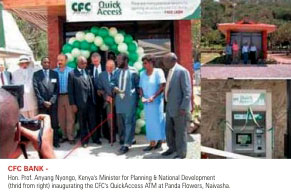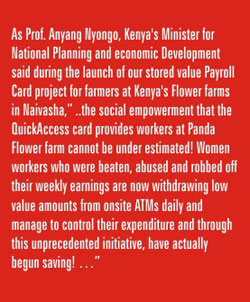The TranZact initiative was a path-breaking initiative by the Technology Associates Group, East & Central Africa's leading IT corporation. TranZact was developed in response to the fast changing, competitive climate of the financial sector landscape in the Africa region. With the proven penetration of GSM based telecommunication services in the continent, financial institutions were now able to embrace new communications and payments technologies to increase retail penetration as well as differentiate product offerings with customer segmented focus.
TranZact was integrated from a ground up approach, using a combination of world class payments technologies, modern card solutions, standards-based software, and the new wired and wireless telecommunications technologies all sown together through established business processes. It enables cash deposits and withdrawals by microfinance clients through a network of accredited third-party merchants, such as traders and other small business owners, in rural and peri-urban areas.
For borrowers, TranZact increases access to financial services in a secure manner and saves travel and transaction times by providing a wider network of points of access to funds. It importantly helps reduce transaction costs through increased points of service and the ability to service a larger client base. In addition, by increasing the return and decreasing the overhead costs on each loan, TranZact allows more capital to be made available to disadvantaged communities.
TranZact facilitates the electronic processing of the clients transaction data for the financial institutions.
It also builds client history necessary for the creation of an electronic records system that may assist in the future serviceability of a loan application for all stakeholders, financial institutions, trade partners and also credit bureaus.
It is capable of providing financial services to both group and individuals, although greater benefits are provided to those institutions that improve their business practices.
Among other advantages, TranZact provides microfinance institutions with:
- A cost-effective way to scale up services in rural areas, even where they do not have branch networks or intermediating commercial banks
- Improved data standards which helps reduce fraud and eliminates double-dipping, or cases in which clients receive multiple loans from the same institution
- Improved efficiency in processing transactional data moving from a highly manual procedure to an automated one
The striking difference in the return on investment (ROI) on a TranZact project when compared with other solutions has been our ability to offer varying value propositions to Commercial Banks who have partnered with us.
Whether the trade-off in earnings was in treasury income in some countries or in government bonds in others, the scale of outreach has been the direct beneficiary of our programs.
 TranZact's core microfinance functionality leverages a key relationship between three key constituents - clients, agents/merchant, and the MFI. In this model, PoS terminals are installed at merchant locations, such as gas station franchisees, airtime resellers or community stores all that had a seemingly well-spread, country-wide, network. These merchants thus became “agents” of the MFI. Clients that visited a local agent did not have to travel as far to tranZact with the MFI - make loan payments or deposit money. The client exchanged cash, directly with the local agent, who acted as a virtual extension of the MFI, providing increased flexibility and reduced costs associated with banking. The clients are the greatest beneficiaries of this model. TranZact's core microfinance functionality leverages a key relationship between three key constituents - clients, agents/merchant, and the MFI. In this model, PoS terminals are installed at merchant locations, such as gas station franchisees, airtime resellers or community stores all that had a seemingly well-spread, country-wide, network. These merchants thus became “agents” of the MFI. Clients that visited a local agent did not have to travel as far to tranZact with the MFI - make loan payments or deposit money. The client exchanged cash, directly with the local agent, who acted as a virtual extension of the MFI, providing increased flexibility and reduced costs associated with banking. The clients are the greatest beneficiaries of this model.
 Our experience with the CFC Bank Kenya project tackled the problem that women farm workers at Kenya's flower farms had their earnings taken from them by family members at the end of the day, or had their funds spent in unplanned ways. The ability to easily stop at a virtual bank on a frequent basis provides the potential to dramatically increase the amount of savings. Our experience with the CFC Bank Kenya project tackled the problem that women farm workers at Kenya's flower farms had their earnings taken from them by family members at the end of the day, or had their funds spent in unplanned ways. The ability to easily stop at a virtual bank on a frequent basis provides the potential to dramatically increase the amount of savings.
Clients on these projects were found to have dramatic impacts on their financial stability and on the funds that the MFI has to make additional loans.
Since the agents receive a fee for providing a transaction service, they are also beneficiaries of this model.
TranZact in Malawi for example has demonstrated that an agent can have an attractive additional business with many hundreds of regular clients that transact multiple times a month. And the MFI can achieve a positive ROI on their investment in a relatively short period of time, with their renewed ability to increase scale and serve many more clients.
Analysis indicates that extending the reach of microfinance into rural areas through these virtual agents will be much less expensive than the current branch model.
Business Process change synchronised with Technology delivers the greatest return
TranZact has been built on industrial strength technology and has been proven under many of the infrastructure challenges in the developing economies, where obstacles such as frequent power outages, unreliable telecommunication services, limited technical support, and high levels of illiteracy are severe.
TranZact fundamentally is an EFT technology solution, which provides the opportunity to update and innovate business processes. Through such innovation, technology can become a lever in creating the potential for an industry to achieve dramatic increases in scale.
Indeed TranZact's success mirrors other striking examples in the global financial sector.
When credit cards were first introduced in the United States, merchants called an 800 number to verify funds before accepting a credit card payment - a process that could take 5 minutes or more. It is little wonder that this innovation did not take off. It was only when technology reduced the card authentication and authorization processes to less than a minute that credit cards became a widespread phenomenon. Additionally, credit card usage began to soar, the business models for financial services began to change. The technology enabled dramatic scale, data mining, and improved the industry's ability to manage risk. In essence, the business models and the underlying technology evolved together to create what has become more than a mulit-trillion per year industry.
Our projects in Africa commence after taking stock of the existing business processes and starts with the engagement of a business consultant who delivers a project scope with the processes centralized to enable multi-branch, multi-channel servicing of the client. The bundling of an industry standard core banking system as well as an industry standard EFT switch guarantees industry standardization and best business practice adaptation. And the fact that TranZact is delivered through a local team it is easy to adopt and embrace as we speak the same language. Also the fact that TranZact serves many more customers locally, the MFI has easy reference to technical support and operational support as well as the comfort in numbers rendering them in safe company!
The TranZact initiative is quickly gaining momentum region-wide. In our new initiatives with Africa's regional Microfinance institutions we are now deploying newer, innovative solutions in collaboration with Cellular Network Operators who have globally set pace micro-finance empowerment through the onward vending of airtime through a network of GSM payphones
Innovative yet appropriate technologies for emerging markets.
Emerging markets require creative technology solutions that are tailored to their unique, and often challenging, needs environments where telephone connectivity is erratic, electricity sources unreliable, technical support limited or non-existent, and much of the customer base illiterate. Innovation should find a balance between the best that technology has to offer, the constraints of the local context and more importantly the ability to acquire local counseling, guidance during implementation and ongoing, local support during the lifecycle of the project. It also needs to find a balance between simply adhering to existing business practices and driving toward business model innovation. Taken together these conflicting forces provide a serious
challenge, and TranZact addresses these during our entire design, implementation and ongoing support processes.
TranZact's implementation methodology continually balances between technology that is “appropriate” and solutions that are “practical”. This indeed is our most valuable proposition as we constantly innovate while customizing to the users' local environment. This flexibility is TranZact's key differentiator from solutions designed for mature market products. TranZact is also architected for low cost and is a true blend of the core elements that would be expected in any enterprise software solution, with alterations required to maximize the effectiveness of the solution in less robust environments.. The total cost of a solution includes:-
- all the hardware to run the solution,
- the technical support team required to maintain the solution,
- and the cost of all required infrastructure elements.
TranZact's implementation methodology at an MFI includes a careful dissection of their operational procedures in excruciating detail. All the elements of the group payment process are discussed and documented. Resultant flow charts are transformed into our Customer Specifications Document (CSD) and ultimately scoped into the project design. TranZact's project engagement finds a key balance between product innovation, local realities, and technical & business re-engineering.
Our Malawi project showed the greatest potential and return as the bank who was the principle project driver adapted an agent model in which merchants were designated as virtual bankers.
However, while the fundamental attraction to clients was the large number of points of access at which they could perform financial transactions, the acquisition, training and support of agents represented a significant cost centre, particularly as the agent network grew.
To obviate this natural Catch-22, where the larger the network, the costlier the costs for the MFI, we introduced additional revenue streams into the business model. One key revenue stream was to enable the agent re-sell electronic airtime vouchers through the PoS terminal and yet another was a money transfer transaction service where cash collected at the agent could be used as a Cash dispensing outlet for the Bank/MFI as well as a point of collection for a remittance beneficiary!
This type of co-operation and cross-selling helped sustain the low transaction cost as well as energise the overall service offering to he clients. The capability to now harness a win:win partnership between Bank/MFI and Agent ensured that service uptime and quality was maintained consistently. This model also allowed a sustainable way to extend the points of presence in remote and rural areas.
The cross-selling also removed another fundamental resistance to co-operation, where the competitive advantages of the MFI and the agent were equally energized to equally tap into the transaction revenues that the clients delivered to them both. |